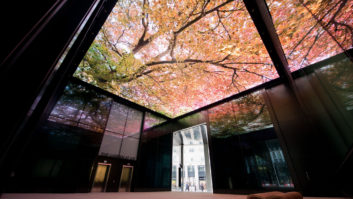In recent times, LED technology has developed to the point where it has become a serious rival to LCD. Previously unthinkable – it had pixels the size of light bulbs (well, almost…) that made it ideal for high visibility outdoor displays – sub-millimetre pixel spacing has seen it become a real contender for many of the applications and environments in which LCD currently reigns supreme. This leads one to ponder whether LCD displays are in fact under threat and consider if LED is poised to become the dominant display technology.
What, though, are the advantages claimed for LED technology that are starting to make it appear so attractive? It turns out, they are numerous.
“LED displays feature a self-emitting light source which provides better colour reproduction, especially in areas where there is a lot of natural light,” says Christian Czimny, R&D director at Absen Europe. “This provides higher brightness compared to backlight illumination for LCD displays.”
“The image processing speed of LED displays is much faster than that of LCD,” claims Steve Scorse, vice president, EMEA at Unilumin. “In fact, it is so fast moving that images look crisper. LED in narrow pixel pitch now has a refresh-rate 0f 3,840Hz – so the video image looks great on camera, even at the fastest shutter speeds.”
Superior viewing angle
“LED displays also have considerably superior viewing angles compared to tiled LCD videowalls, and often the off-axis viewing of the different LCD panels in an LCD wall appear as having different brightness levels,” he continues. “They also have superior uniformity in both brightness and colorimetry than LCD videowalls.”
“Typically LED displays don’t require a glass plane in front of the display, which reduces reflection and glare that can compromise the image quality of an LCD in direct sunlight,” believes Jason Melby of Daktronics. “They also deliver superior contrast. Beyond that, the technology is designed to handle a variety of environmental factors that can prove to be challenging for LCD solutions.”
And then, there are the issues of maintainability and cost of ownership.
“It’s much easier and more cost effective to replace a small LED unit from a module, or even a module, than it is to replace an entire LCD display within a videowall,” notes Czimny.
“LED has a typical lifetime of 100,000 hours,” adds Scorse. “That’s more than 12 years at 24/7 operation. The useful operating life of LED is typically more than double that of comparable LCD.”
Melby also has thoughts on the subject. “The upfront cost of a quality LED display will likely still be more expensive than the upfront cost of an LCD-based videowall,” he says. “The value of an LED-based system becomes more apparent when you look at the cost of the system over the life of the display. Commercial LCD solutions have a significantly shorter life than a comparable LED solution. A commercial LCD solution may need to be replaced two, three or even four times during the life of a quality LED solution.”
He also makes the entirely valid point that it’s all too easy to talk about LED as if it is all the same.
Diverse offering
“The current marketplace for LED displays has a very diverse offering of solutions with a significant variance in price, quality and durability,” he notes. “Some of the lower quality solutions may get close to cost parity with LCD solutions, but may have much shorter lifespans than traditional LED solutions. It will be important for buyers to understand the variables that contribute to cost and durability.”
Others note the superior power efficiency of LED-based screens, resulting in lower running costs and better environmental performance.
For all the claimed advantages of superior brightness and contrast, better viewing angles, greater ease of maintenance, lower cost of ownership, reduced susceptibility to environmental factors and so on, any discussion of LED technology in relation to LCD technology when it comes to displays invariably focuses on what most see as its most important benefit.
“A key advantage of LED displays compared to LCD displays is their flexibility,” believes Christian Orcin, vice president of product marketing at Leyard EMEA. “LED displays can accommodate almost any shape and size videowall without having to stick to a display’s fixed size or form factor. LED displays are uniquely well-suited for large videowalls of more than 100in.”
According to Absen’s Czimny, the use of LCD displays in a videowall environment results in a content-to-content gap of anything up to 3.7mm – impairing the perceived image.
Anything you want it to be
“The number one advantage of LED over LCD is that it is completely seamless,” says Liam Winter, head of LED at rental and distribution company PSCo. “You can create a videowall without the bezels, ensuring no interruption to content. As a videowall technology, and with its ability to enable convex and concave curves, wrap around corners, columns, mosaics and so on, it offers the potential for outstanding creativity. LED is anything you want it to be.”
That assertion may be somewhat true – but it holds less true for the ‘classic’ display market hitherto the province of LCD-based screens.
“Currently, LCD-based displays are easier to install and operate, provide typically higher resolutions compared to direct view LED and offer a substantially lower initial cost,” points out Thomas Walter, who is section manager strategic product marketing, NEC Display Solutions Europe. “This is why LCD-based displays are still considered to be the dominant choice as this technology offers a very good price/performance ratio.”
“LCD-based displays provide a crisp viewing experience, leading to effortless readability for many indoor – and even outdoor – applications such as advertising, plus meeting room applications and many more,” he continues. “In addition, LCD displays are well prepared for demanding signage applications as they support media playback integration – as with our Raspberry PI compute modules, and interactivity for touch applications such as our InfinityBoard collaboration hub – and can be protected against vandalism in public spaces through the use of protective glass or housings.”
“However,” he adds, “for more specialist applications, where specific requirements regarding size, brightness, outdoor capabilities, architectural integration and seamless large canvasses are the main decision criteria, direct view LED offers a compelling alternative.”
www.absen-europe.com
www.daktronics.com
www.leyard.com
www.nec-display-solutions.com
www.psco.co.uk







